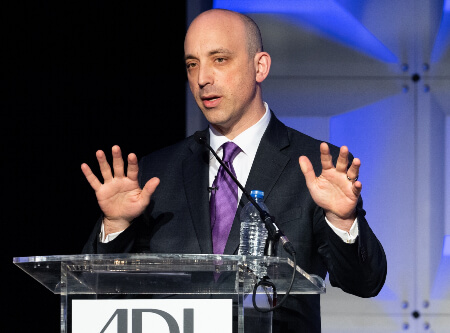By Asaf Shalev
NEW YORK — When it comes to anti-Semitism on social media, the algorithms governing the major platforms shoulder some of the blame for their reach.

ADL CEO Jonathan Greenblatt pictured in 2018. (Michael Brochstein via Getty)
The ADL announced March 8 that it has built an algorithm called the Online Hate Index, describing it as the first tool ever developed to measure anti-Semitism on social media platforms.
The program can sift through millions of posts quickly to detect anti-Semitic comments and aid in their removal.
This system uses an algorithm informed by artificial intelligence to find and classify posts as possibly anti-Semitic. Those posts are then fed to a team of both volunteers and experts, who use their judgment to make the final call.
The system also tracks whether the posts are eventually taken down.
The new index was needed because social media companies are not being transparent enough about their efforts to curb the spread of hate speech on their platforms, says ADL CEO Jonathan Greenblatt.
“We will use this tool to hold social media platforms accountable for how well they proactively take down hate and how well their content moderators respond to reports,” Greenblatt says.
One of the project’s goals is to demonstrate that if the ADL can develop the technology to track anti-Semitism, surely Silicon Valley can do so as well.
Social media companies have attempted to tackle anti-Semitism in the past. Facebook (now known as Meta) has stumbled following its decision to ban Holocaust denial on its platforms; engineers developed screens that also sometimes blocked legitimate educational posts meant to spread awareness about the Holocaust.
For its first analysis, the ADL used its system to scrutinize Reddit and Twitter, collecting posts from one week in August of last year.
The ADL chose these platforms because they are the only major ones that provide open access to their data. Facebook, by contrast, does not typically allow outside groups to tap in for research.
The algorithm used by the ADL was trained to spot instances of possible anti-Semitism. In a process known as machine learning, human beings had labeled comments as anti-Semitic and fed them to the algorithm, which in turn began recognizing patterns. The more comments the algorithm processed, the better it became at catching the anti-Semitic ones.
Anti-Semitic statements like “Jews are lizard people prove me wrong” and “Jew mind control magic” were among the roughly 2,000 Reddit posts pinpointed by the ADL system, out of some 40 million total comments added to Reddit during that week.
The number of people who view a comment on Reddit is in part determined by whether users “upvote” or “downvote” it — and there’s some good news in this regard. Users are on average scoring anti-Semitic comments a third lower than other types of posts, according to a report ADL published about its analysis.
“Statistical analysis of those scores shows that anti-Semitic content on Reddit is rewarded significantly less than non-anti-Semitic content,” the report said.
For Twitter, ADL estimated there were some 27,400 anti-Semitic tweets among the 440 million posted during the week its software was examined, and that these tweets could have been viewed by as many as 130 million people.
The ADL cautioned that it designed its dragnet to be conservative and that it looked only at English-language text, meaning that video, audio and images were excluded, as well as anything written in a foreign language.
On both platforms, most of the anti-Semitic comments stayed up for months after being posted and were not removed even after the ADL alerted the platforms.
One of the challenges for any attempt to stamp out anti-Semitic speech is defining the term. One contentious issue is deciding when criticism of Israel crosses the line into anti-Semitism.
The ADL report says that its algorithm is trained by in-house experts and volunteers from the Jewish community.
That doesn’t mean human judgment is entirely outsourced to computers. In the ADL’s system, artificial intelligence is used to sift through masses of content, with its human teams ultimately determining which posts constitute anti-Semitism.
To aid them in their decisions, each volunteer gets a primer, which includes a reference to the definition of anti-Semitism drafted by the International Holocaust Remembrance Alliance, which has proven controversial because it focuses on anti-Israel speech.
Some examples in the primer include “claiming that the existence of a State of Israel is a racist endeavor” and “denying the Jewish people their right to self-determination.”
















